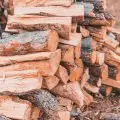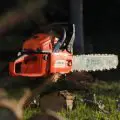You consider the upkeep of your garden and outside areas to be a crucial task. It is extremely necessary to use a chainsaw if you need to cut wood. However, on sometimes, the chainsaw chain becomes heated and makes it challenging to cut wood. and the wood burns as a result.
Although you can see burn scars on the branches and trunks, you are unsure of where the chainsaw’s issue is. Thus, in order to identify the source of the issue and, more specifically, so that you may resume using your chainsaw normally, a few checks are needed.
In this article, we’ll go over these typical causes of a chainsaw burning wood and emitting smoke, along with how to identify and resolve the problem. If you stick with us, you’ll soon be back to cutting your wood!
Table of Contents
- Why Does My Chainsaw Burn Wood as I Cut?
- A Dull Chain Causing Chainsaw to Burn Wood
- Rakers Too High Causing Chainsaw to Burn Wood
- Chain on Backwards Causing Chainsaw to Burn Wood
- Chainsaw Oiler Issue Causing Chainsaw to Burn Wood
- FAQs (Frequently Asked Questions)
Why Does My Chainsaw Burn Wood as I Cut?
The issue of a chainsaw burning wood is more common than you might think, and it is likely the result of:
- A dull chain
- High rakers
- A chain put on backward
- A problem with bar oiler.
A Dull Chain Causing Chainsaw to Burn Wood
A dull chain is unquestionably the most common culprit for a chainsaw smoking and burning wood, and it may happen to the best of us. As they cut, chainsaws generate an enormous quantity of heat. The heat will quickly build up if a chain is dull, which will cause the wood to smoke and finally burn before the chainsaw makes it all the way through the tree.
Under normal circumstances, a sharp chain will cut away wood before the heat has a chance to build up. In this situation, sharpening your chainsaw will completely solve the issue. Keep your chain sharp at all times! Learn all about the Types of Chainsaw Chains in our guide!
How to Check if Your Chainsaw Chain is Dull
You can determine whether your chainsaw needs to be sharpened in a few simple ways:
Larger wood chips should be coming off of a chain that has been sharpened. A chainsaw chain removes wood rather than grinding it, working like a chisel. The chainsaw is probably dull if the chips it produces are more like sawdust than solid chunks.
Wood should be quite simple to cut with a chainsaw. The chainsaw is definitely dull if you find yourself having to exert a lot of force or work it to cut through. On the other hand, some types of wood, like oak and hickory, are inherently harder to cut through than others.
You can typically detect whether a chainsaw is excessively dull by eye inspection. When a chain has to be sharpened, the cutting edges will appear more rounded.
Your chainsaw’s chain will need to be sharpened if it made brief touch with the ground during cutting, even if it was only for a split second. Your chain will quickly become dull from the rocks and sand in the dirt!
Visit our How to Sharpen a Chainsaw Chain article, for more information!
Rakers Too High Causing Chainsaw to Burn Wood
Not only should you be sharpening your chain on a regular basis, but you should also be filing your rakers to guarantee an appropriate cutting depth. Rakers are the metal pieces in front of the tooth that maintain a constant cutting depth. The overall height of the tooth eventually decreases due to frequent sharpening until the raker completely conceals it.
Even if the chain itself is well-sharpened, the saw will be practically unable to cut when this occurs. This may result in a tremendous amount of heat building up, which may cause your chainsaw to start smoking and burning wood.
How to Fix Rakers Being Too High on Chainsaw
You must file the rakers down to an appropriate cutting depth of .025′′ to remedy this problem. To measure the depth accurately and consistently, a depth gauge must be used. To ensure that your chainsaw will cut swiftly, effectively, and without smoke, it is a good idea to check your rakers using a depth gauge each time you sharpen it.
Visit our Chainsaw File Sizes Chart for information on the various sizes.
Chain on Backwards Causing Chainsaw to Burn Wood
A chain that has been attached backward is a humiliating yet incredibly frequent reason why a chainsaw emits smoke and burns wood. A chain should be arranged so that each tooth’s cutting face is facing away from the operator of the chainsaw at the top of the guide bar and toward the operator at the bottom of the bar.
How to Fix Chain on Backwards
Although it can make you feel foolish, putting your chain on backward is fortunately a simple repair! Simply remove the chain and properly reattach it. Rest assured that we have all been there. Only two types of chainsaw owners exist in the world: those who have their chains attached incorrectly and those who tell lies.
Chainsaw Oiler Issue Causing Chainsaw to Burn Wood
An issue with the saw’s oiler system is one of the more annoying and bothersome reasons why a chainsaw is burning wood and emitting smoke. Chain lubrication must be continuous, and when it stops, it can lead to a variety of issues.
If your chainsaw is experiencing issues refueling, there will be more than just a little smoke. The chain may become slack due to thermal expansion, causing sporadic sparks and possibly even causing the chain to fly off the sprocket, and the bar may get discolored from the intense heat (always wear your gear).
You shouldn’t use your saw until it has been fixed because this is a serious issue that has to be addressed as soon as possible.
Check Your Chainsaw’s Bar Oil Level
Checking the levels of bar oil should be your first step if you think the issue may be connected to the saw’s oil system. You have identified your issue if the chainsaw runs out of bar oil. Just remember to refuel the oil chamber each time you fill up with gas and to do so.
Check to see whether the oil is getting to the bar or if the bar oil is full. There are two methods for verifying this:
- Check to see if the underside of the bar appears to be lubricated by gently pulling the chain up from the bar.
- In order to get the chain to start spinning, position the tip of the bar a few inches from the end of a log (without touching it). If the oiler is operating properly, the log that dislodged from the chain should have a clear line of oil spray.
If it appears that no oil is reaching the chain, then you have identified the issue.
How to Fix a Chainsaw Oiler
A blockage is the most frequent reason for a faulty oiler. It is quite common for debris to sometimes build up and cause some blockage because chainsaw use generates so much sawdust. Fortunately, this can also be fixed quickly. Simply take out the bar, clean the oil hole on the bar, and the chainsaw’s oil dispenser of any dirt. You should incorporate this procedure into your routine chainsaw maintenance.
If there isn’t any material obstructing the flow, a broken oiler or stripped gear are the most likely culprits. Oil is delivered to the bar by a variety of gears. These gears on some types of chainsaws may be composed of plastic and can easily melt or strip.
You must take the clutch apart to inspect each component individually and repair any broken components as needed. Visit your neighborhood repair shop with the saw for assistance.
FAQs (Frequently Asked Questions)
Why is my chainsaw burning the wood?
A chainsaw burning the wood happens more frequently than you might imagine, and this is usually due to a dull chain, high rakers, a chain that has been attached backward, or a problem with the bar oiler.
How do you know if your chainsaw isn’t oiling?
There are typically 2 methods to check if your chainsaw isn’t oiling. The first involves inspecting the underside of the bar by pulling the chain gently to see if it’s lubricated. The other is to place the tip of the bar a few inches from the end of a log to get the chain to start spinning (without touching it). The log that came loose from the chain should have a clean line of oil spray if the oiler is working properly. If there is no oil spray, you know it isn’t working.





